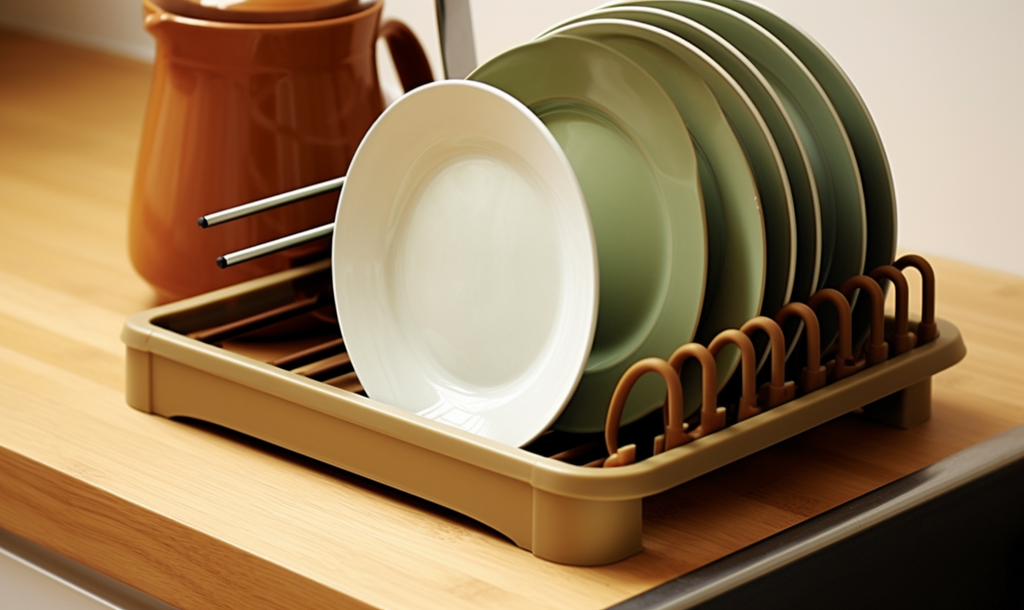The allure of spray painting lies in its versatility, offering a transformative touch to household items like dish drying racks. However, before diving into this DIY endeavor, it's vital to grasp the nuances of the process and the essential considerations. This knowledge ensures a successful outcome, preserving not just the aesthetics but also the functionality of the item. From material assessment to proper preparation and the right choice of paint, these steps set the stage for a seamless and satisfying spray-painting experience, breathing new life into your kitchen essentials.
Understanding the Importance of Proper Ventilation
Before embarking on a spray painting endeavor, meticulous evaluation of the surroundings is paramount. Adequate ventilation isn't solely about safety; it's integral for optimal outcomes. Ample airflow not only minimizes health risks from inhaling fumes but also facilitates a seamless, even application of paint. This essential airflow assists in the drying process, ensuring a flawless finish, and prevents the accumulation of airborne particles, resulting in a professionally painted dish drying rack.

Outdoor vs. Indoor Painting:
Before embarking on a spray painting endeavor, meticulous evaluation of the surroundings is paramount. Adequate ventilation isn't solely about safety; it's integral for optimal outcomes. Ample airflow not only minimizes health risks from inhaling fumes but also facilitates a seamless, even application of paint. This essential airflow assists in the drying process, ensuring a flawless finish, and prevents the accumulation of airborne particles, resulting in a professionally painted dish drying rack.
Safety Precautions:
Prioritizing safety measures during indoor painting sessions is paramount. To enhance air circulation, strategically position fans or open windows to create a well-ventilated environment, effectively dispersing fumes and preventing their accumulation. Additionally, wearing a mask or respirator equipped with suitable filters is crucial to minimize inhalation of paint particles or volatile organic compounds (VOCs), safeguarding respiratory health. Furthermore, donning protective gear like gloves and goggles shields against accidental contact with paint or chemicals, ensuring a safer painting experience and minimizing potential health risks associated with exposure to paint fumes and substances.

Choosing the Right Paint and Application Method
Factors to Consider Before Spray Painting:
Ensuring the right paint compatibility with the dish drying rack's material is fundamental. Each material—be it metal, plastic, or wood—demands a paint type that adheres suitably and endures over time. Choosing a paint formulated specifically for the rack's material guarantees not only proper adhesion but also resilience against wear, environmental factors, and regular use. This thoughtful selection ensures a durable and long-lasting finish, adding both aesthetics and functionality to your repainted dish drying rack.

Material Compatibility:
Choosing the appropriate paint type tailored to the specific material of the dish drying rack is paramount. Opting for paints formulated explicitly for metal, plastic, or wood guarantees not only optimal adhesion but also endurance against wear and tear. This selection ensures that the paint bonds effectively with the rack's surface, providing resilience against moisture, corrosion, or physical impacts, ultimately resulting in a durable and long-lasting finish that maintains its integrity over time.

Application Method:
Determining the most suitable application method involves assessing the rack's material and intricacies. While spray painting offers a smooth, even finish, it might not be ideal for all surfaces. Materials like intricate woodwork or textured surfaces might benefit more from brush or roller application, allowing better control over the paint and access to crevices. Moreover, intricate designs or detailed patterns might be challenging to execute with a spray gun. Considering these factors helps in choosing the most effective application technique, ensuring the paint adheres well and achieves the desired finish without compromising the rack's functionality or aesthetics.
Factors to Consider Before Spray Painting a Dish Drying Rack
Material Composition:
Before applying spray paint to a dish drying rack, it's essential to scrutinize the rack's material composition. Optimal materials for this DIY endeavor include metals like stainless steel or aluminum and specific plastics. It's imperative to thoroughly clean and completely dry the rack beforehand to ensure a smooth painting surface and better paint adhesion.
Paint Selection:
Selecting appropriate paints specifically formulated for the material of the dish drying rack, like enamel for metal or rust-resistant spray paints for added durability, is essential. These tailored paint options ensure longevity and resilience against moisture and wear.

Preparation:
Before commencing the painting process, begin by disassembling the dish drying rack to access every surface thoroughly. Lightly sanding each component helps create a uniform and smooth base for the paint, ensuring better adhesion and a professional finish. Employ meticulous care with painter's tape, covering and safeguarding any areas not intended for painting. This step guarantees a neat and precise outcome, maintaining the rack's functionality while enhancing its visual appeal after the painting project is complete.

Steps to Spray Paint a Dish Drying Rack
Preparation:
Before starting the painting process, it's crucial to meticulously clean the rack using a mild detergent and water to remove any grease, grime, or residues. Ensuring the rack is entirely dry is essential for optimal paint adhesion and a flawless finish.

Priming:
Before applying paint, it's crucial to prime the dish drying rack with a primer formulated explicitly for its material. This step enhances paint adhesion, provides a smoother surface, and ensures a more durable and long-lasting finish for your DIY project.

Spray Painting:
To achieve an impeccable finish while spray painting, maintain a distance of 8-12 inches between the spray can and the rack. Utilize smooth, overlapping strokes in a consistent manner, ensuring comprehensive coverage. Applying multiple thin coats rather than a single heavy coat facilitates better adhesion, minimizes drips or unevenness, and results in a more uniform and professional-looking finish for your dish drying rack.

Drying and Reassembly:
Ensuring proper drying time is crucial for an impeccable finish. Adhering to the paint manufacturer's instructions for drying intervals between coats is vital. After the final coat, exercise patience as the paint cures—this step is pivotal for durability. Only reassemble the rack once the paint has fully cured, ensuring a lasting and flawless finish that withstands regular use and washing without compromising its appearance.
Conclusion
Engaging in spray painting for your dish drying rack isn't just a creative endeavor but an opportunity to infuse your kitchen space with personal flair. By diligently adhering to meticulous preparation, employing compatible materials, and executing a methodical application, you not only enhance the aesthetic appeal but also fortify the rack's endurance and practicality. Embrace this DIY journey as a chance to revitalize your kitchen, ensuring that your dish drying rack becomes a seamless blend of style and functionality that stands the test of time.

FAQs
Q: Can I spray paint any dish drying rack?
A: It depends on the material. Metal and certain plastic racks can be painted after proper cleaning and preparation.
Q: What type of paint should I use?
A: Choose paints suitable for the rack's material, like enamel or rust-resistant spray paints, for long-lasting results.
Q: Do I need to prime the dish drying rack before painting?
A: Yes, using a primer formulated for the rack's material promotes better paint adhesion and durability.
Q: How many coats of paint should I apply?
A: Apply multiple thin coats to achieve a smooth, even finish, allowing each coat to dry completely before applying the next.
Q: How long should I wait before reassembling the rack after painting?
A: Follow the drying time specified on the paint can, ensuring the paint has fully cured before reassembly.
-------------------------------------------------------------
Your encouragement and support are the driving force of our creation. If you want to support us, you can pay a small amount of Bitcoin or Ethereum to the following address:
Bitcoin:
bc1q56xsdwhnva969w38808yu3erxjrxqludn9ehg9

Ethereum:
0x555C43d02140634250e965F963733Fb32F974D67














